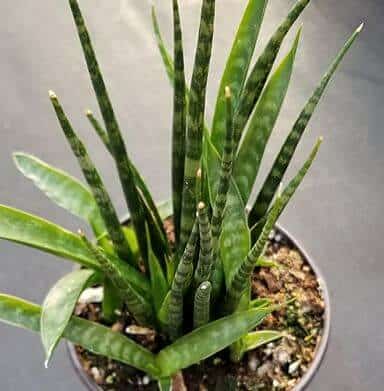Last Updated on January 5, 2023 by a Friendly Gardener
If you want a truly hardy indoor houseplant that will thrive on neglect, the Sansevieria is the plant for you. Often referred to as the Snake plant, Mother-in-law’s Tongue, or St. George’s Sword, this is a popular species of houseplant that is well-loved for its ability to adapt to low light conditions. There are approximately 70 species of Sansevieria to select among as well as numerous cultivars. Native to western Africa, they belong to the Asparagaceae family.
The Sansevieria ‘Danish Crown’ develops in the shape of a crown hence the name and boasts lovely, variegated foliage with mottled lime green spots on a dark green background. This is a rare cultivar that features rigid leaves with an upright growth habit.
An evergreen perennial, the Sansevieria with its sword-like foliage, can grow to as little as six inches to heights of eight feet. This kind of houseplant is very easy to care for and is thought to be relatively indestructible. They do well in bright indirect light or in the shadows. These plants are slow growers when cultivated indoors but will grow more rapidly if exposed to several hours of bright indirect light.
Sansevieria Danish Crown Plant Care
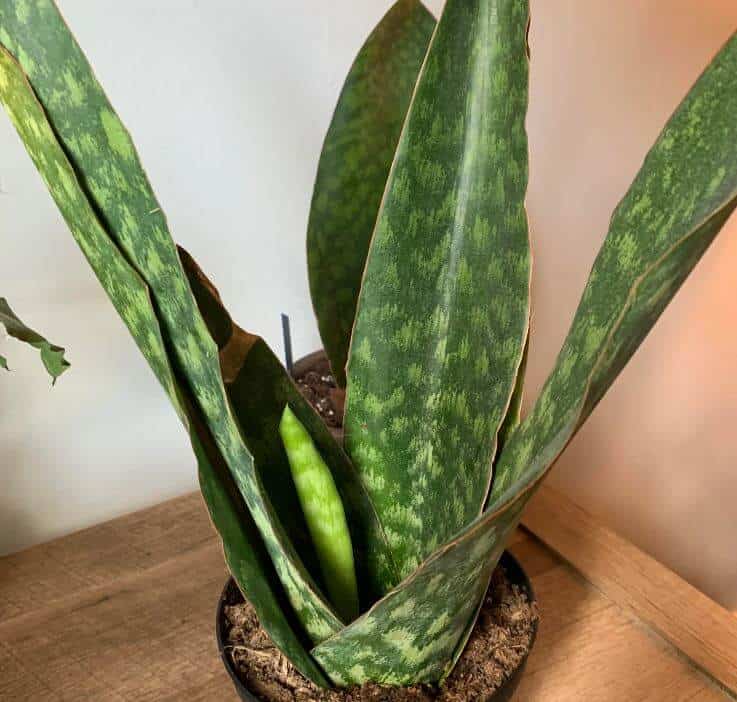
This is a fantastic, rare cultivar that is great for beginner gardeners due to its indestructibility. It does exceptionally well in containers. The Snake plant prefers warm weather and will suffer somewhat in cooler temperatures. The Sansevieria is drought-resistant so if you travel or have the habit of forgetting watering, select this plant. It requires little watering and is susceptible to root rot if overwatered.
The average lifespan is five to ten years but some plants have been known to live for upwards of twenty-five years in the proper environmental conditions.
Soil

A loose potting mix is fine if it ensures excellent draining. They do well in sandy soils, so you can amend potting soil with coarse sand to improve drainage. Select a soil mix that has a low peat content to prevent problems with drainage. You can also use a soil mix formulated for cacti.
Light
The Danish Crown loves consistent indirect light and can manage a little bit of direct sun exposure. It’s important to be aware that leaves can scorch, however, these plants do adapt to full sun exposure. They also do very well in very dim lighting.
Water
With this plant, the soil should be permitted to dry out between waterings. In the winter, you can reduce watering to once a month. If you must err, opt for underwatering rather than overwatering.
Temperature
The Sansevieria Danish Crown prefers warm temperatures that measure between 70° and 90° F. This plant will suffer if temps drop below 50°F. The Snake plant is frost sensitive and can die because of frost exposure. Keep your plant away from vents and drafts.
Feeding
Feed the Danish Crown Sansevieria with a fertilizer formulated for cacti or a houseplant fertilizer with a 10-10-10 NPK. You can also use a 20-20-20 NPK fertilizer if you dilute it to half-strength. Feeding should only be done during the growing season. Do not fertilize in the winter.
Pruning
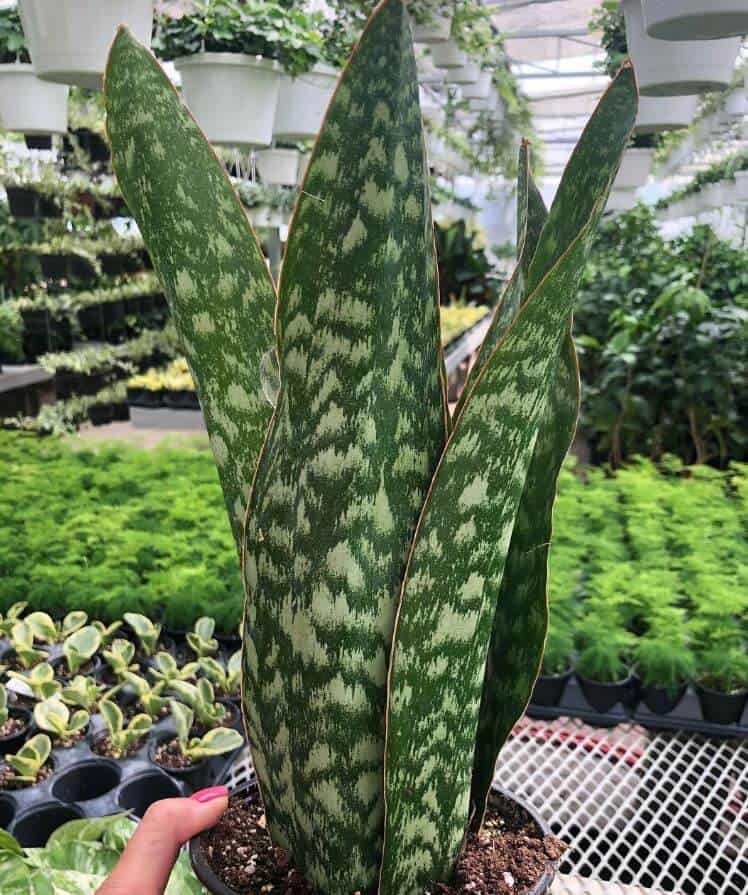
Pruning a Sansevieria should be limited to removing damaged or mature foliage. Trim at the base of the plant just above the soil surface. It’s recommended that you trim during the spring or growing season. The Sansevieria can be trimmed during the winter, but this can stress the plant. To control a Snake plant’s height, remove the tallest leaves. Trimming leaves will encourage new growth.
Potting and Repotting the Danish Crown Sansevieria
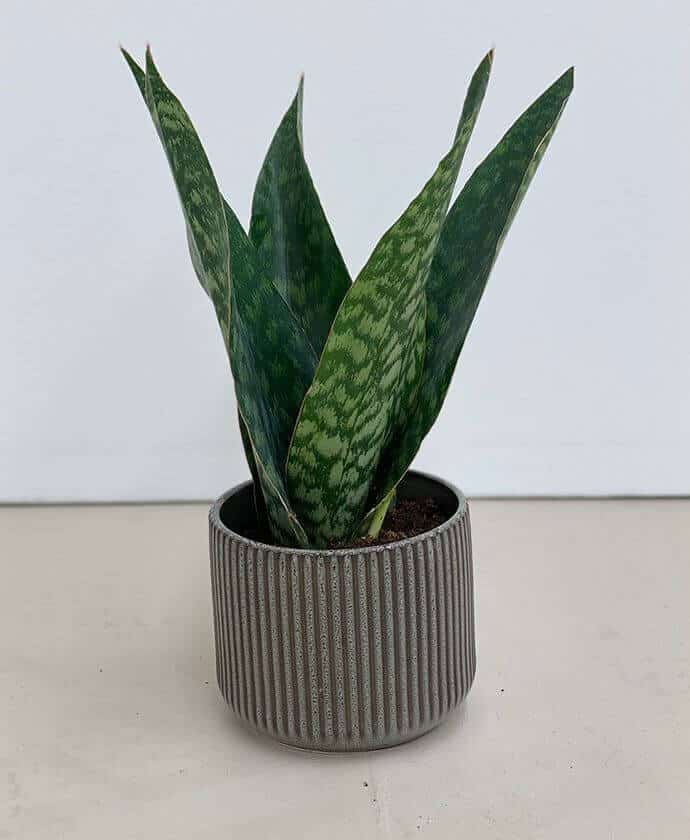
When it comes time to repot, choose a sturdy container as roots can break through containers. Although they are slow growers, with more sun exposure they may need repotting. Repot your plant in the spring.
Sansevieria Danish Crown Propagation
A Snake plant can be propagated easily through division during the spring or summer months. To divide a Danish Crown, it should be at least four inches tall. You can also remove offshoots from the base of the plant and repot them individually.
- Remove the plant’s root ball from the soil.
- Brush away soil from the root rhizome.
- Divide the plant into sections using a sterile knife. Each section of the plant must have some roots attached.
- Replant the sections individually in pots, water, and place them in a sunny spot.
- For offshoots, cut the plantlet and place the cut end in cactus soil mix. Water and put it in a sunny spot.
The Sansevieria can also be propagated using leaf cuttings.
- With a sterile garden knife, trim off a healthy leaf.
- Place the cut end in a glass vase or jar of water.
- Place in partial sun and watch for root development.
- Every second week change the water to prevent bacteria development.
- When the roots develop, replant them in soil, and water and find a sunny location.
Another method is to trim the leaf, allow the cut end to callous for 24 hours and then place it in cactus soil mix. Water and place in a sunny spot.
Sansevieria Danish Crown Problems
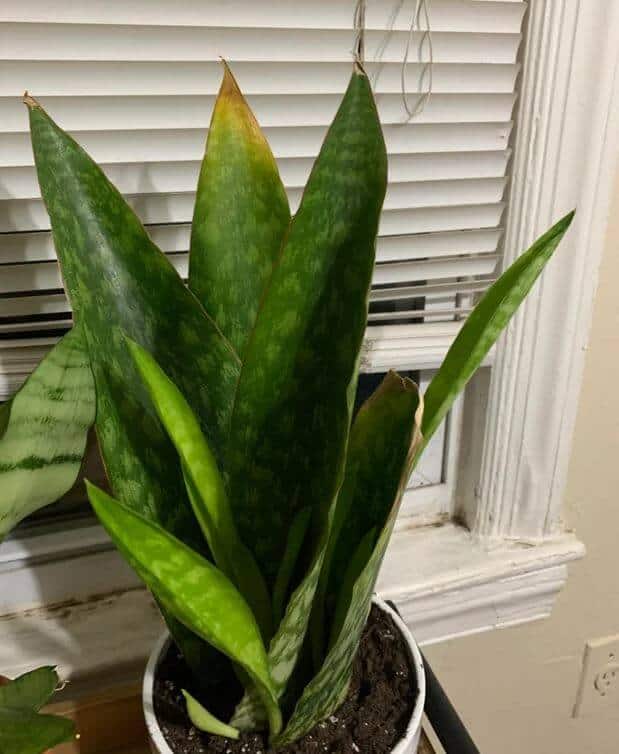
As a tropical plant, the Sansevieria should not be exposed to temperatures below 50°F. If the plant is outside, move it indoors for overwintering.
The Danish Crown Sansevieria is susceptible to most houseplant pests so watch for aphids, spider mites, scales, gnats, whiteflies, and mealybugs. Remove pests manually and treat your plant with insecticidal soaps or neem oil.
Most Snake plant problems are related to overwatering which leads to root rot or fungal infections. Root rot is characterized by foul-smelling soil and mushy foliage. Remove the rhizome, cut away infected areas and replant in fresh cactus soil.
Brown or yellow leaves can point to a number of conditions including root rot, overwatering, and pests. Determine which condition your plant is suffering from and adjust your care plan.
Should leaves curl, it may indicate that your plant is home to a thrip infestation. Remove curling leaves and treat with neem oil or insecticidal soap.
If foliage begins to droop, excessive watering or too little light may be to blame. Move to a spot with more light and reduce watering.
Danish Crown Sansevieria Toxicity
Sansevieria plants are known to be toxic to both dogs and cats.

